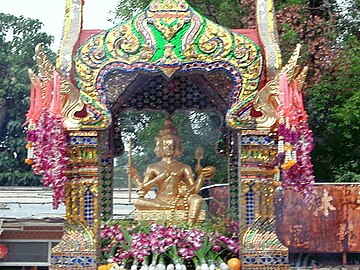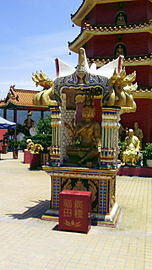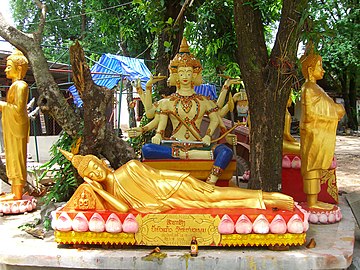Phra Phrom
This article needs additional citations for verification. (May 2009) |

Phra Phrom (Khmer: ព្រះព្រហ្ម, Preah Prom,Template:Lang-th; from Sanskrit: Brahmā, ब्रह्मा) is the Khmer and Thai representation of Trimurti member Brahma (the creator), also worshiped in Buddhism as Brahmā, who according to Buddhist cosmology is lord of Brahmaloka (the highest heavenly realm)[1] Phra Phrom is colloquially known outside Thailand as the Four-Faced Awakened One (四面佛, Sìmiànfó) or Four-Faced God (四面神 Simianshen) among Chinese folk religious worshipers, among whom the faith of this god has spread in the latest decades. One of the well-known Angkorian temple in Cambodia with the name of this Hindu deity is Ta Prom temple.
Worship
Cambodia


Preah Prom or Brahma has been worshiped in Cambodia for thousands of years. Throughout the history of Cambodia, Brahma along with other Hindu deities were worshiped since Funan, Chenla, Angkor, and the present day. Cambodia was first influenced by Hinduism during the beginning of the Kingdom of Funan.[2] A statue of Brahma was also found stationed in one of the shrines of the 7th-century Sambor Prey Kuk temple and is now exhibited at the Cambodia National Museum.[3] Hinduism was one of the Khmer Empire's official religions. Cambodia is the home of the holy temple of Angkor Wat, the largest Hindu temple in the world. The main religion adhered to in the Khmer Kingdom was Hinduism, followed by Buddhism. Initially, the kingdom revered Hinduism as the main state religion.[2] Today plenty of Brahma statues are exhibited in both the Cambodia and Foreign Museums.
Thailand
Worshipers of the god usually offer incense, candles, jasmine flowers or jasmine garlands and young coconut milk (with water in them) in their worship, usually placing these offerings before all four heads of Phra Phrom, each head representing a different aspect of the deity; it is believed each side of Phra Phrom offers different blessings. Another common way of worship is to place wooden elephant statues on the altar to honor him. Phra Phrom is also known to admire Thai classical music, which is played near larger scale outdoor altars, accompanied by dancers. For a small fee, the dancers include worshiper's name into the songs they sing while dancing. Worshipers of Phra Phrom are also usually advised to abstain from consuming meat. It is also believed that worshipers have to make good on any promises made to the deity else misfortune will befall them instead of the fortune that was asked for. Items needed for prayers are available in the premises of the shrine.
The main example of this representation of Brahma is the statue at the Erawan Shrine in Bangkok, where the faith of the god has its origins in modern times.[4] The golden dome of the Government House of Thailand also contains a statue of Phra Phrom.
Spread of the cult among ethnic Chinese
As early as the 1980s, the popularity of the Erawan cult of Brahma from its inceptions in Thailand spread, accompanied by faithful reproduction of the structure of the shrine and the image, among overseas Chinese in other countries of Southeast Asia (Singapore, Indonesia and Malaysia), in Taiwan, and in China, with shrines established in Hong Kong, Shanghai and Guangzhou.
-
An altar dedicated to Brahma in Kaohsiung, Taiwan.
-
Brahma statue at the Erawan Shrine, Bangkok
-
Statue of Brahma in a Laotian Buddhist temple.
-
Brahma statue in Wat Phothivihan, Kelantan, Malaysia.
-
Brahma riding the Hong bird, old statue.
See also
General articles
References
- ^ Robert E. Buswell Jr.; Donald S. Lopez Jr. (2013). The Princeton Dictionary of Buddhism. Princeton University Press. p. 142, Article on brahmaloka. ISBN 978-1-4008-4805-8.
- ^ a b "Hinduism in Southeast Asia", Wikipedia, 2020-03-04, retrieved 2020-03-07
- ^ "(PDF) Estimated Construction Order of the Major Shrines of Sambor Prei Kuk Based on an Analysis of Bricks". ResearchGate. Retrieved 2020-03-07.
- ^ "Archived copy". Archived from the original on 2009-05-23. Retrieved 2009-07-08.
{{cite web}}: CS1 maint: archived copy as title (link)










